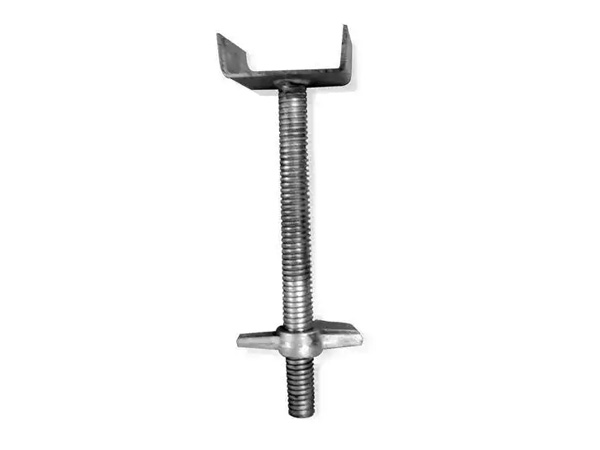- Site Navigation -

Formwork Prop Head
The Formwork Prop Head(also known as the formwork adjustable support)is the core adjustment and load-bearing component in the building formwork support system.......
The Formwork Prop Head(also known as the formwork adjustable support)is the core adjustment and load-bearing component in the building formwork support system,which is mainly used to connect the formwork main beam(such as wood,sectional steel)and scaffolding vertical rods,realize the precise control of formwork elevation through lead screw adjustment,and bear the vertical load during concrete pouring,which is a key accessory to ensure the stability of formwork structure and concrete forming quality.
Main classifications and applicable scenarios
According to the construction requirements(load,formwork type,adjustment range),the formwork top can be divided into different types,and the selection needs to match the specific engineering scenario:
1.Classified by lead screw material
Solid top support:The lead screw is a whole round steel(such as Q235,45#steel),with high strength and strong bearing capacity(single-point load-bearing is usually 20-50kN),suitable for scenarios with large loads,such as long-span floor slab pouring,beam-column formwork support.The disadvantage is that it has a large dead weight and is slightly laborious to transport and install.
Hollow top support:The lead screw is a thick-walled seamless steel pipe(wall thickness≥3mm),which weighs 30%-40%lighter than the solid top support of the same specification,and has high installation efficiency,suitable for civil building floor slabs and wall formwork with medium load.Note:Hollow lead screws should not be used in long-term load-bearing or overload scenarios to avoid pressure and deformation of the lead screw.
2.Classification according to pallet form
Flat top support:The support plate is a pure square steel plate,which is suitable for supporting the main beam of the wooden square(the wooden square is tightly fitted to the flat plate and is not easy to slide).
Groove top support:The top of the bracket is pressed with a U-shaped groove(groove width matches the size of the section/wooden square),which is suitable for supporting the main beam of the section(such as channel steel,I-beam)or round steel pipe,which can prevent the lateral displacement of the main beam,and is often used in bridge formwork and high support formwork system.
3.Classification according to the scope of regulation
Conventional adjustment of the top support:The effective adjustment length of the lead screw(i.e.,the range of movement of the nut)is usually 150-300mm,which meets the needs of most standard floor heights(2.8-3.5m)of formwork elevation adjustment,and is the most commonly used type in building construction.
Extended adjustment of the top support:The lead screw effectively adjusts the length of≥300mm(up to 600mm),which is suitable for scenarios with high floor height or height deviation in the formwork support system,such as jump floor buildings and temporarily raised formwork supports.
Core use and construction role
The Formwork Prop Head is the"bridge"of the formwork support system,connecting the vertical rod and the formwork,and the core role is reflected in three aspects:
Precise adjustment of formwork elevation:During construction,the formwork elevation error can be controlled within±2mm by rotating the adjustment nut and driving the lead screw to lift and lower,ensuring that the flatness and design elevation of concrete floor slabs and beams(such as floor slab thickness and beam bottom elevation)meet the requirements of the specification.
Transmitting vertical loads:When pouring concrete(such as floor slab pouring,the dead weight of concrete is about 24kN/m³),the load bearing the formwork is transmitted to the ground or foundation through the support plate→lead screw→base→vertical rod,and the top support needs to ensure that the load transfer path is stable to avoid local compression damage.
Compensate for support errors:There may be height deviations during the installation of scaffolding poles(such as inaccurate cutting length of vertical poles and uneven ground),and the adjustment function of the top support can compensate for these deviations without the need to re-cut the vertical poles and improve construction efficiency.








